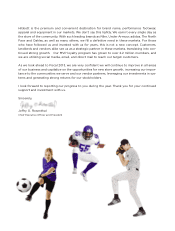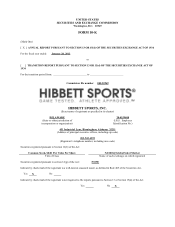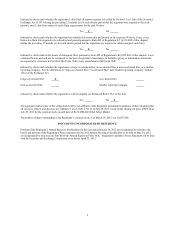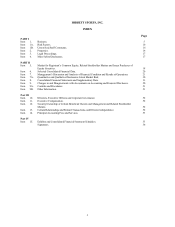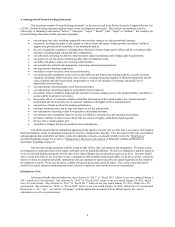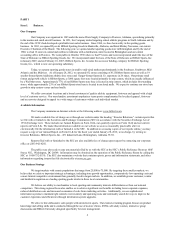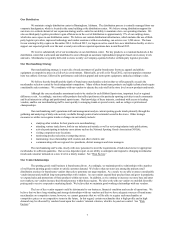Hibbett Sports 2012 Annual Report Download - page 14
Download and view the complete annual report
Please find page 14 of the 2012 Hibbett Sports annual report below. You can navigate through the pages in the report by either clicking on the pages listed below, or by using the keyword search tool below to find specific information within the annual report. 10
Item 1A. Risk Factors.
You should carefully consider the following risks, as well as the other information contained in this report, before
investing in shares of our common stock. If any of the following risks actually occur, our business could be harmed. In that case, the
trading price of our common stock could decline, and you might lose all or part of your investment.
Risks Related to Our Business and Industry.
A downturn in the economy could adversely affect consumer purchases of discretionary items, which could reduce our net
sales.
In general, our sales represent discretionary spending by our customers. A slowdown in the U.S. economy or other
economic conditions affecting disposable consumer income, such as volatile fuel and energy costs, depressed real estate values,
employment levels, inflation, business conditions, consumer debt levels, lack of available credit, interest rates and tax rates may
adversely affect our business. A reduction in overall consumer spending that causes customers to shift their spending to products
other than those sold by us or to products sold by us that are less profitable could result in lower net sales, decreases in inventory
turnover or a reduction in profitability due to lower margins.
A slower pace of new store openings may negatively impact our net sales growth and operating income and we may be unable
to achieve our expansion plans for future growth.
The opening of new retail stores has contributed significantly to our growth in net sales. In light of the challenging
economic environment that has faced real estate developers over the past three years, we have slowed down the pace of our new store
openings compared to our historical rate. We expect that this pressure on the commercial market and developers will continue
throughout Fiscal 2013 and that we will be able to increase our overall store base by approximately 5% in Fiscal 2013 compared to
4% in Fiscal 2012 and Fiscal 2011. A slower pace of new store openings may negatively impact our net sales growth and operating
income.
We have grown rapidly, primarily through opening new stores, from 67 stores at the beginning of Fiscal 1997 to 832 stores
at January 28, 2012. Our continued growth depends, in large part, upon our ability to open new stores in a timely manner and to
operate them profitably. Successful expansion is subject to various contingencies, many of which are beyond our control. In order to
open and operate new stores successfully, we must secure leases on suitable sites with acceptable terms, build-out and equip the
stores with furnishings and appropriate merchandise, hire and train personnel and integrate the stores into our operations.
In addition, our expansion strategy may be subject to rising real estate and construction costs, available credit to landlords
and developers and landlord bankruptcies that could inhibit our ability to achieve our desired rate of growth. We may also face new
competitive, distribution and merchandising challenges different from those we currently face. We cannot give any assurances that
we will be able to continue our expansion plans successfully; that we will be able to achieve results similar to those achieved with
prior locations; or that we will be able to continue to manage our growth effectively. Our failure to achieve our expansion plans
could materially and adversely affect our business, financial condition and results of operations. Furthermore, our operating margins
may be impacted in periods in which incremental expenses are incurred as a result of new store openings.
Our estimates concerning long-lived assets and store closures may accelerate.
Our long-term success depends, in part, on our ability to operate stores in a manner that achieves appropriate returns on
capital invested. This is particularly challenging with the volatility of the current economic environment and customer behavior. We
will only continue to operate existing stores if they meet required sales or profit levels. In the current macroeconomic environment,
the results of our existing stores are impacted not only by a volatile sales environment, but by a number of things that are outside our
control, such as the loss of traffic resulting from store closures by significant other retailers in our stores’ immediate vicinity.
The uncertainty of the economy, coupled with the volatility in the capital markets, affects our business and, ultimately, our
revenue and profitability. To the extent our estimates for net sales, gross profit and store expenses are not realized, future
assessments of recoverability could result in impairment charges. In addition, if we were to close stores, we could be subject to costs
and charges that may adversely affect our financial results.
Our stores are concentrated within the Southeast, Southwest, Mid-Atlantic and Midwest regions of the United States, which could
subject us to regional risks.
Because our stores are located primarily in a concentrated area of the United States, we are subject to regional risks, such
as the regional economy, weather conditions and natural disasters such as floods, droughts, tornadoes and hurricanes, increasing
costs of electricity, oil and natural gas, as well as government regulations specific in the states and localities within which we operate.
We sell a significant amount of team sports merchandise that can be adversely affected by significant weather events that postpone
the start of or shorten sports seasons or that limit participation of fans and sports enthusiasts.


